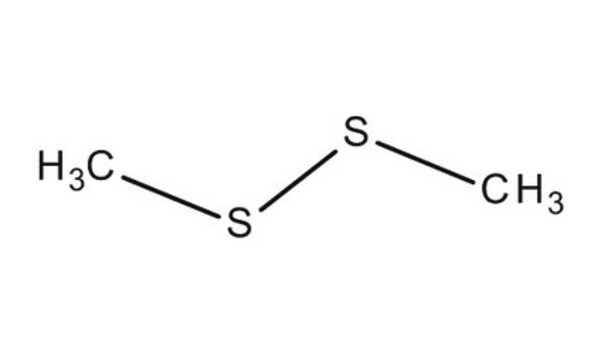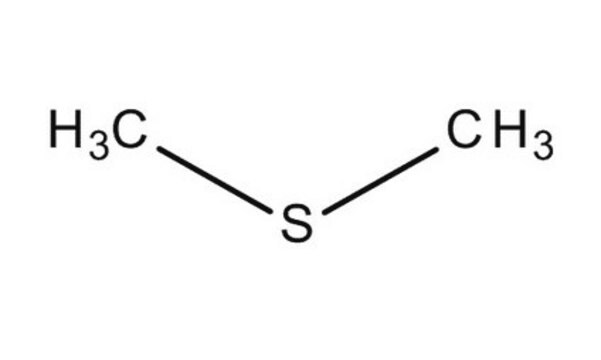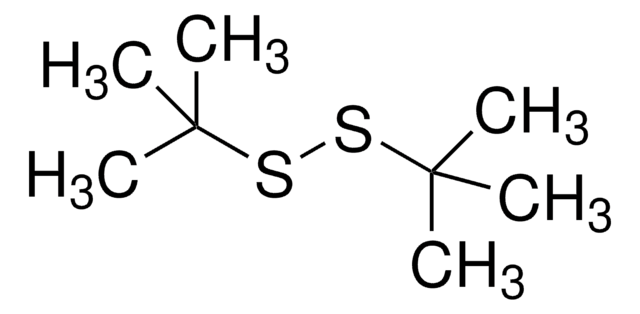471569
Dimethyldisulfid
≥99.0%
Synonym(e):
DMDS, Methyldisulfid
About This Item
Empfohlene Produkte
Dampfdichte
3.24 (vs air)
Qualitätsniveau
Dampfdruck
22 mmHg ( 20 °C)
Assay
≥99.0%
Selbstzündungstemp.
>572 °F
Expl.-Gr.
16 %
Brechungsindex
n20/D 1.525 (lit.)
bp
109 °C (lit.)
mp (Schmelzpunkt)
−85 °C (lit.)
Dichte
1.046 g/mL at 25 °C (lit.)
Funktionelle Gruppe
disulfide
SMILES String
CSSC
InChI
1S/C2H6S2/c1-3-4-2/h1-2H3
InChIKey
WQOXQRCZOLPYPM-UHFFFAOYSA-N
Suchen Sie nach ähnlichen Produkten? Aufrufen Leitfaden zum Produktvergleich
Verwandte Kategorien
Allgemeine Beschreibung
Anwendung
Rechtliche Hinweise
Signalwort
Danger
Gefahreneinstufungen
Acute Tox. 3 Inhalation - Acute Tox. 3 Oral - Aquatic Acute 1 - Aquatic Chronic 1 - Eye Irrit. 2 - Flam. Liq. 2 - Skin Sens. 1 - STOT SE 1 Inhalation - STOT SE 3
Zielorgane
Central nervous system, Upper respiratory tract
Lagerklassenschlüssel
3 - Flammable liquids
WGK
WGK 3
Flammpunkt (°F)
59.0 °F - closed cup
Flammpunkt (°C)
15 °C - closed cup
Persönliche Schutzausrüstung
Eyeshields, Faceshields, Gloves, type ABEK (EN14387) respirator filter
Hier finden Sie alle aktuellen Versionen:
Besitzen Sie dieses Produkt bereits?
In der Dokumentenbibliothek finden Sie die Dokumentation zu den Produkten, die Sie kürzlich erworben haben.
Kunden haben sich ebenfalls angesehen
as thiolate at the bridge site
Protokolle
Separation of 4-Methyl-2-pentanone; Dimethyl disulfide; Hexanal; 3-Methylpentane; Acetone
Separation of Sulfur dioxide; Hydrogen sulfide; Carbonyl sulfide; Methanethiol; Ethanethiol; Dimethyl disulfide; Carbon disulfide
Separation of 2-Ethyl-3-methylpyrazine; 1-Methylpyrrole; 2,3-Dimethylpyrazine; 2,5-Dimethylpyrazine; 2-Ethylpyrazine, ≥98%, FG; 2,3-Diethylpyrazine; 2-Methylpyrazine; Carbon disulfide; Dimethyl disulfide; 2,6-Dimethylpyrazine
Unser Team von Wissenschaftlern verfügt über Erfahrung in allen Forschungsbereichen einschließlich Life Science, Materialwissenschaften, chemischer Synthese, Chromatographie, Analytik und vielen mehr..
Setzen Sie sich mit dem technischen Dienst in Verbindung.











